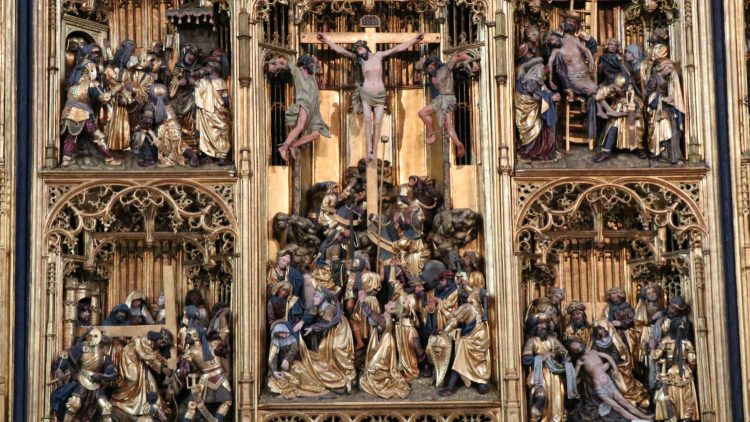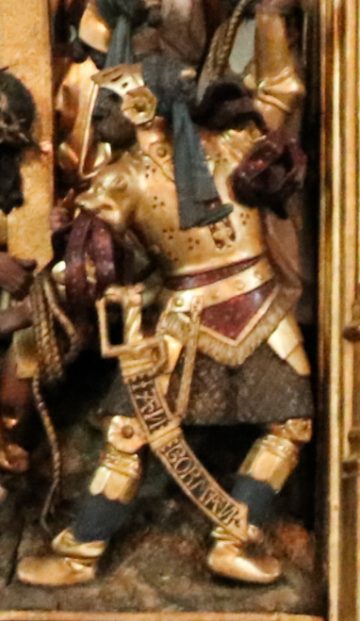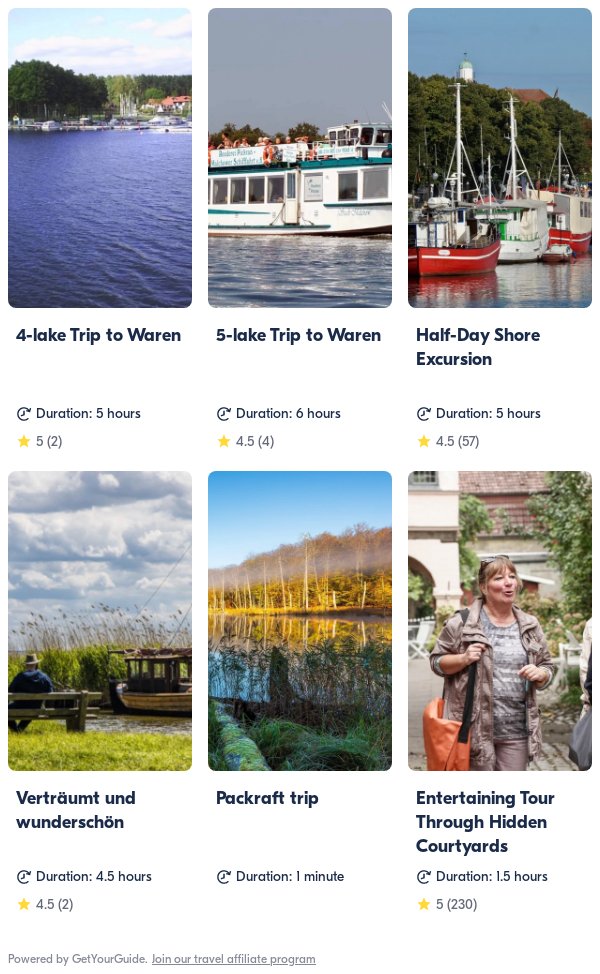The brick Gothic St Marienkirche in Güstrow in Germany is famous for its magnificent Borman winged altar retable with 181 painted wood-carved figures.

St Mary’s parish church in Güstrow near Rostock in Mecklenburg-Vorpommern in northern Germany is a large brick Gothic hall church. Although part of the church dates from the early 16th century, it was extensively remodeled in a fitting neo-Gothic style during the late 19th century. The main reason to visit the Marienkirche is not the architecture but rather the interior fittings including the huge and magnificently carved late-Gothic Borman winged altar, which depicts Christ Passion in 13 scenes with 181 individual characters. The organ is frequently played in concerts.
Pfarrkirche St. Marien in Güstrow
The parish church of St Mary’s (Pfarrkirche St. Marien) is a large brick Gothic hall church in Güstrow. Parts of the building survived from a five-nave church from 1508, which was severely altered in the 1880s.
The current Marienkirche has three naves of equal height, which uniquely for northern Germany, has a typical Flemish roof of three peaks running parallel along the length of the church — the resulting three gables are best seen from the eastern side.
The western tower appears a bit squat despite its height of 53 m. It has none of the elegance of some of the slender spires of many other brick Gothic churches in northern Germany. From 1718 to 1920 it housed the town’s paid watchman in a small apartment. It is around 190 steps to this tower room with great views of Güstrow and the surrounding countryside.
The copper plates of the baroque canopy, like Barlach’s Der Schwebende (Floating Angel sculpture) in the nearby Güstrower Dom, were melted down as part of the war effort in 1942 and only replaced in 1980.
Interior of St Marien in Güstrow

The interior is mostly neo-Gothic and beautifully painted to emphasize its gothic lines and striking vaulting. The church was completely restored in recent years with the art, especially the pre-reformation works, the main attractions.
Güstrower Borman Altar in St Marien

The most important artwork by far in the St Marienkirche in Güstrow is the large winged altar. This retable from the workshop of the Brussels craftsman Jan Borman is of European importance.
The late Gothic altar was donated to the church in 1522. It has two wings that may be opened in two ways to either show six paintings or far more impressive, 13 scenes with 181 painted oak wood-carved figures. Fully opened, it measures 520 cm wide and 220 cm high (over 400 cm including the frame).
A decade-long restoration project was recently completed. It removed some previous restoration works and ensured that the colors are period correct. The frame and the top decorations are neo-Gothic replacements but based on the original.

The 13 wood-carved scenes show the Biblical events of the Passion of Christ and Easter:
- Last Supper
- Garden of Gethsemane
- Jesus before Caiaphas
- Ecce Homo
- Pilate Washes His Hands
- Carrying of the Cross (including the sword with “Jan Borman”)
- Crucifixion
- Descent from the Cross
- Lamentation
- Burial
- Resurrection
- Women at the Grave
- Ascension
On the predella are Christ and the 12 apostles while the top row has Christ as Man of Sorrows with Mary and a variety of saints.
The altar is attributed to the Brussels-based workshop of Jan Borman, although it is unclear exactly which of several similarly named carvers were responsible. It is very rare for a wood-carved altar from the Low Countries of the period to actually have the name of the artist on the work but “Jan Borman” is clearly carved on the sword of a soldier in the carrying the cross scene (lower left next to the central crucifixion scene).
The six paintings are usually attributed to Bernaert van Orley, a student of Raphael, and consist of portrayals Mary, St Katherine, Peter, and Paul.
Other Gothic Artworks in the Marienkirche in Güstrow

The small oak Pieta near the front of the church dates from the late 15th century and is the oldest artwork in the church. (Note the Barlach Angel of Hope terracotta relief (1933) hanging nearby — it has only been in the church since the 1980s.)
The monumental triumphal crucifixion scene is by a local Mecklenburger artist who was probably inspired by a similar display in the Dom in Lübeck. The over life-sized figures were carved from oak in 1516. Having Mary and John next to the crucified Christ is not unusual but the addition of Adam and Eve is less common. The crucifix was removed from the church in 1650 and only returned in 1928 through the influence of Barlach, who appreciated its artistic value and the quality of the carving. (The Havelberger Dom has a similar large crucifix from 1280 that is still painted, as this one would have been, while the double-sided cross altar in the magnificent brick gothic Münster in Bad Doberan was restored to its full splendor.)
In the southern portal is a Strahlenkranzmadonna — a haloed Madonna sculpture from 1522.
Post-Renaissance Art in the Marienkirche in Güstrow
The St Marienkirche became Lutheran in 1533 but as in so many other St Mary churches in Germany, the original name stuck. Lutherans do not venerate the Virgin Mary similar to the Roman Catholic doctrine nor acknowledge saints but often maintain the original names and art in churches — in some cases too Catholic works only reemerged centuries later from storage.
The sandstone pulpit (Kanzel) is by Rudolf Stockmann and was completed in 1583 to commemorate fifty years of Lutheran preaching in the church. The decorations follow the Lutheran emphasis on the importance of preaching the sermon.
The Renaissance-style decorative pew (Ratsgestühl) was completed in 1599 and is still used by the town counselor during events. The church has several Renaissance and Baroque epitaphs and funeral monuments — although none as impressive as those in the choir of the Dom zu Güstrow.
The organ case (Orgelprospekt) by Paul Schmidt is Baroque from 1764. The present organ was installed in 1931 by Firma Sauer but has been renovated and modernized several times since. It has 2916 pipes and 43 stops (Registern) played from three manuals and a set of pedals.
Also note the painted spiral staircase (in the lobby) leading to the organ, as well as the painted underside of the organ case that almost forms a tent-like canopy when entering the church from the western side.
Visitors Information for the Marienkirche in Güstrow
The Sankt Marien church in Güstrow is usually opened as follows:
December to March (mostly closed in January):
- Tuesday to Saturday from 11:00 to noon and 14:00 to 15:00
- Sunday and Holidays from 14:00 to 15:00
April, May, October
- Tuesday to Saturday from 10:00 to noon and 14:00 to 16:00
- Sunday and Holidays from 14:00 to 15:00
June to September
- Monday to Saturday from 10:00 to 17:00
- Sunday and Holidays from 14:00 to 15:00
Admission is free. Small charge for photography.
Information inside the church is mostly in German only.
Concerts are frequently held in the Marienkirche. The organ is usually played on Tuesday evenings during the summer season (in rotation with the Dom) — expect change from €10. Even for larger concerts tickets rarely cost more than €20.
Visiting Güstrow in Mecklenburg-Vorpommern
Güstrow is a small town of around 30,000 inhabitants around 30 km inland of Rostock in the north German state Mecklenburg-Vorpommern. It was the residential seat of the Dukes of Mecklenburg-Güstrow during the 16th and 17th century but since the line died out in 1695 Güstrow had a quiet provincial existence.
The top sights in Güstrow include the Dom with Barlach’s Floating Angel and huge Ducal epitaphs, the St Marienkirche with its rich interior (Borman Altar), and the Renaissance Schloss (the modern interior with a major paintings gallery is being renovated but the exterior and park are open for free).
Güstrow refers to itself as Barlachstadt as the German sculptor Ernst Barlach lived here from 1910 until his death in 1938. The Gertrudenkapelle to the west of the town center has works from his Güstrow period while the larger Atelierhaus a few kilometers to the south of Güstrow has a larger display of his work in his former house, studio, and modern exhibition center.
Güstrow is around half an hour’s drive to the south of Rostock or two hours (200 km) to the north of Berlin. The town center is very walkable — park near the Schloss and stroll to all the sights.
Trains to Güstrow take around 30 minutes from Rostock on the at least hourly S-Bahn train or 20 minutes on the infrequent Regional Express trains. Train travel from Berlin takes two to three hours (direct a few times per day but often requiring transfers). The train station is around a km to the north of the town center.
Güstrow is also a pleasant town to spend the night in with hotels ofter far cheaper than in nearby Rostock — see Tripadvisor recommendations. Drivers may prefer the very pleasant countryside options in the forests and near lakes.












